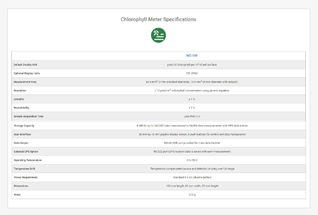Non-Destructive Measurement
The meter measures the ratio of radiation transmittance from two wavelengths: red, which is strongly absorbed by chlorophyll, and near infrared, which is not absorbed by chlorophyll. Since the meter gauges the wavelengths, and does not rely on entering the leaf, users are able to make measurements non-destructively and nearly instantaneously (measurement time is less than 3 seconds). This facilitates rapid measurement of multiple leaves and the monitoring of the same leaves over time.
Storage Capacity and Internal GPS
Memory is allocated to data storage, which allows for 160,000 logged measurements. A mini USB port also enables direct connection to a computer to download your data. Chlorophyll meters come with a complimentary standard mini USB to USB cable adaptor for data downloading. New internal GPS inside the meter allows field data to be geo-referenced and stored, with a storage capacity of 94,000 measurements.
Plant Species
Specific crop species settings in the meter include edible species such as rice, wheat, soybean, barley, pepper, tomato, pea, kohlrabi, Waldmann's green lettuce, buttercrunch lettuce, corn, sorghum, coffee, spinach, grapevine, strawberry, cherry, blackberry, arugula, collard greens, kale, romaine lettuce, and swiss chard. The meter also includes plant species such as quaking aspen, European birch, paper birch, crimson king maple, Norway maple, Japanese maple, boxelder, crab apple, purple leaf sand cherry, lilac, forsythia, cannabis, and hops, as well as a general setting used for all other species.






